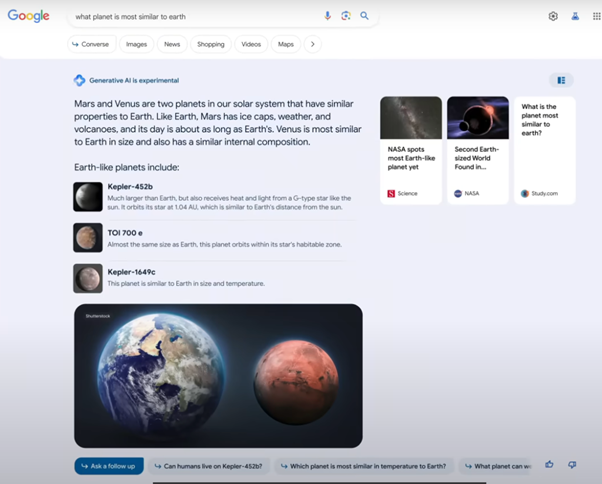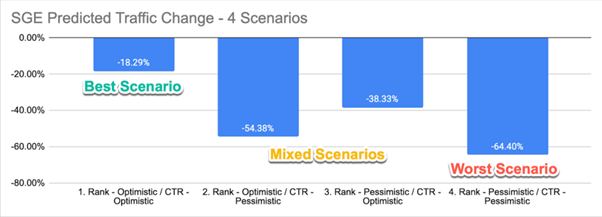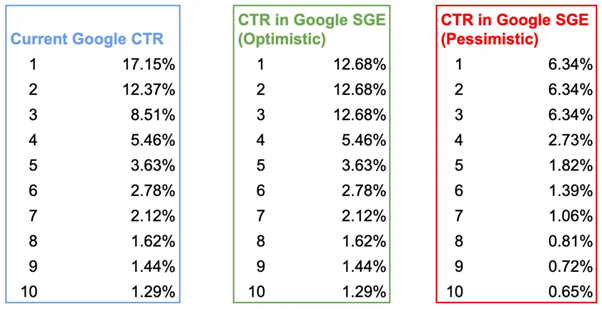Now in its testing stage, Google’s upcoming update, called Search Generative Experience, harnesses the power of artificial intelligence to offer users a more organised and rational search experience than ever before – modeled after the ChatGPT version of Bing. However, this evolution is likely to have major consequences on SEO, with significant changes expected in terms of the positions of results in the SERP and traffic volumes. So, should it be considered a danger or an opportunity for SEO? Let’s dive into how Google SGE will likely influence organic traffic and what optimisation levers will need to be activated to counter its potential adverse effects.
What is Google SGE?
SGE (Search Generative Experience) introduces AI into Google’s search algorithm. Thanks to this feature, the user sees AI-generated answers displayed via a specific section of the SERP, especially for queries considered complex.
The idea is simple: with the help of an AI-based program, Google SGE aims to answer user requests directly. The SGE banner displays automatically generated text based on information collected from pages indexed by the search engine. In doing so, the user doesn’t need to click on an organic link since the answer is provided in its entirety – unless they want to deepen their search by clicking on the available sources or organic links positioned below the banner. The answer provided by Google SGE is composed by AI in real-time, allowing it to take into account the most recent information related to the topic in question. For complex queries, the user can thus count on a complete answer that avoids going through multiple steps for their search.
How is the AI answer displayed in Google SGE?
When a user makes a query, an SGE banner appears at the top of the SERP (above the links), unfolding the text generated by AI. Next to this content, a carousel highlights the three primary sources used by Google SGE to produce its answer. Here is an example of a SERP in SGE, taken from the presentation video published by Google:

During testing, there were instances where the AI-generated answer also included clickable links within the text’s body. A feature that Google SGE could retain in the future.
Finally, below the text, a conversational mode proposes that the user extend their search without formulating a new query simply by specifying their request. To this end, they can add text themselves or select a question from a list of suggestions: the AI responds by providing additional details.
Why is Google launching Search Generative Experience?
There are two complementary answers to this question. On the one hand, it’s about Google leveraging the possibilities provided by artificial intelligence and following in the footsteps of its competitor Bing, which announced the integration of ChatGPT into its search engine early on. We remember that this surprise announcement, following the success of OpenIA’s tool, had pushed Google to present Bard – its own generative AI hastily. The Search Generative Experience was born from this technological race.
On the other hand, it’s clear that the search engine intends to further its aspiration to provide internet users with a comprehensive and uninterrupted experience, or in other words, to keep them on the SERP for as long as possible instead of sending them to third-party pages. This is not an entirely new ambition: features like the Answer Box and Position Zero already provide users with definitive answers. With Google SGE, if the experience is satisfactory, users will tend to end their browsing session without leaving the search engine.
What will the impact of Google SGE be on SEO?
Naturally, we can expect Google SGE to affect SERP results and, more broadly, the practice of organic SEO. Two consequences seem inevitable in light of the tests conducted so far: reduced click-through rates and an ever-increasing importance attributed to the top results.
- A drop in click-through rates? AI is now able to easily generate a coherent and relevant answer when asked a simple question. Therefore, when the user obtains a satisfactory answer via the Google SGE banner, they no longer have any reason to click on an organic link to further their search. Consequence: we should expect a significant drop in traffic for a large number of answers, particularly informative articles, FAQs and explanatory content. As a result, generic informative content may lose a significant part of what constitutes its SEO value.
- A Top 3 of growing importance? We can also expect traffic to be more concentrated than ever in the Top 3 of the SERP. It’s important to understand that Google SGE synthesises information from certain pages. However, these pages will be highlighted in the carousel: they will form a new essential Top 3 for internet users, benefiting from optimal visibility – close to the AI-generated response. In short, with the Search Generative Experience, the SEO objective could focus solely on the Top 3, to the detriment of other positions, as users will tend to no longer scroll down to exit the SGE banner.
Should we expect traffic losses with SGE?
The potential traffic losses due to Google SGE needs to be explored further. Although the tests on the Search Generative Experience are scheduled to continue until the beginning of 2024, initial analyses by SEO experts confirm this trend. In a study conducted by Search Engine Land on 23 sites, the sharp decline in traffic ranges from 18% at best to 64% in the worst-case scenario.

The survey focused on a specific sector, technology, and informational keywords. It highlights a probable accentuation of the ‘zero-click’ trend, with users forgoing organic links once they have obtained the desired answer.
However, these results must be nuanced. And this is for several reasons.
- In most cases, the tests carried out show minimal differences between the classic SERP and the SGE version SERP, regardless of the new banner. This means that, below the box containing the AI answer, the positioning of the results remains identical in both cases. We also find elements such as the Knowledge Panel, images and videos. So, if users scroll down, they will face the same links.
- The Search Engine Land study also highlights optimistic scenarios with sites whose SEO performance has increased considerably due to Google SGE. In their panel, one domain thus recorded a 219% increase in traffic.
- Targeted SEO optimisation work could significantly improve the content affected by the most substantial traffic losses and thus counter the effects of the Search Generative Experience. This would involve writing content adapted to Google SGE, which would be less generic but more qualitative, relevant, and detailed.
- SEO experts can develop strategies to target the Top 3 and integrate the carousel dedicated to sources. These results benefit from optimal visibility (even better than in the current SERP). However, as the AI answer remains relatively simple in its wording, the user who wants to know more will be encouraged to click on the links prominently displayed next to the generated text, as these appear more relevant from the outset than the others (since chosen by Google to formulate an answer). In its study, Search Engine Land claims to have implemented an experimental framework in this direction, with encouraging results.
- Currently, the potential effect of the Search Generative Experience on click-through rates is not proven, and the results of the various studies certainly do not apply to all cases. It is just as possible that the SGE banner has no impact on the traffic recorded by the top 10 results of the SERP. This is shown in the table below, which compares optimistic and pessimistic forecasts. With one variation, however, as the top three results are placed side by side in the carousel rather than one above the other, we can expect an identical click-through rate for each of them.

- The ranking on Google SGE is not fixed. For the same query, the algorithm sometimes offers different results: the AI answer remains the same, but the pages displayed in the carousel change. There are also instances where this feature does not trigger at all!
Moreover, Sundar Pichai is reassuring about the changes the Search Generative Experience brings. For Google’s CEO, integrating SGE into the SERP, which he compares to the shift from desktop to mobile, should not fundamentally call into question the company’s business model – including sending traffic to websites via organic and paid links.
What SEO optimisation levers can be used to take advantage of Google SGE?
Google’s new feature leaves many questions unanswered. However, taking into account the conclusions of the available studies, we can identify four optimisation levers that, once SGE is in place, will help webmasters and SEO experts take advantage of this AI-powered tool.
- Create content that responds to specific search intents. Because Google SGE relies on interactivity, the user can extend their query by adding elements or asking other questions, thus formulating a more complex request. In terms of SEO, this means swapping generic keywords for long-tail expressions that reflect a stronger intent.
- Strengthen domain authority. Indeed, the authority of a domain name is likely to play a major role among the positioning criteria in the carousel. In the example of the SGE interface given at the beginning of the article, we can see that the sources highlighted by Google correspond to reputable domains: the Science journal, the NASA website, and a recognised online learning platform. Authority can be strengthened by obtaining backlinks and offering users in-depth, detailed and relevant content – with maximum regularity.
- Group content to match diversified search paths. This approach allows you to adapt your pages to the complete answers offered by Google SGE. To do this, content is grouped by thematic clusters in order to exploit each angle and each variation around the same subject. The algorithm can use this to answer complex queries without having to draw from different sources.
- Fortify your local SEO strategy. In fact, for local searches, it appears that the companies best positioned in the Local Pack or on Google Maps are also those that are most often found in the SGE banner. Enhanced work on local SEO should thus favour a good placement in the Search Generative Experience results for this type of query.
Google SGE is a complex update whose full ramifications are impossible to assess – especially since the firm itself has not yet settled on certain points, such as the positioning of paid ads (an essential issue for a search engine that intends to remain profitable). At this stage, we can only make some reasonable hypotheses about the effects of this evolution on ranking, click-through rates, and, more broadly, SEO strategies. However, we will have to wait until the official launch of the Search Generative Experience to measure the change fully.











